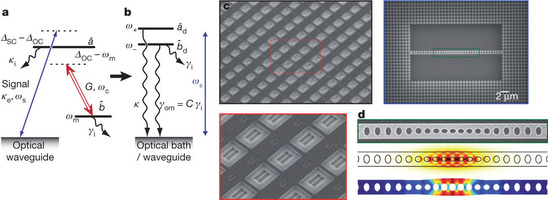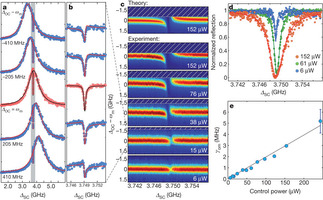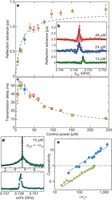Controlling the interaction between localized optical and mechanical excitations has recently become possible following advances in micro- and nanofabrication techniques1, 2. So far, most experimental studies of optomechanics have focused on measurement and control of the mechanical subsystem through its interaction with optics, and have led to the experimental demonstration of dynamical back-action cooling and optical rigidity of the mechanical system1, 3. Conversely, the optical response of these systems is also modified in the presence of mechanical interactions, leading to effects such as electromagnetically induced transparency4 (EIT) and parametric normal-mode splitting5. In atomic systems, studies6, 7 of slow and stopped light (applicable to modern optical networks8 and future quantum networks9) have thrust EIT to the forefront of experimental study during the past two decades. Here we demonstrate EIT and tunable optical delays in a nanoscale optomechanical crystal, using the optomechanical nonlinearity to control the velocity of light by way of engineered photon–phonon interactions. Our device is fabricated by simply etching holes into a thin film of silicon. At low temperature (8.7 kelvin), we report an optically tunable delay of 50 nanoseconds with near-unity optical transparency, and superluminal light with a 1.4 microsecond signal advance. These results, while indicating significant progress towards an integrated quantum optomechanical memory10, are also relevant to classical signal processing applications. Measurements at room temperature in the analogous regime of electromagnetically induced absorption show the utility of these chip-scale optomechanical systems for optical buffering, amplification, and filtering of microwave-over-optical signals.
Figures at a glance

Figure 1: Optomechanical system.
a, Level-diagram picture, showing three ‘levels’ that represent the optical mode â, the mechanical mode
 and the ‘bath’ of optical waveguide modes. The transitions between modes driven by the signal and control beams are indicated by blue and red double-headed arrows, respectively. Wavy black arrows indicate decay from the different modes. See text for definitions of symbols in a and b. b, The control beam at ωc drives the transition between the optical and mechanical mode, dressing the optical and mechanical modes, resulting in the dressed state picture with dressed modes âd and
and the ‘bath’ of optical waveguide modes. The transitions between modes driven by the signal and control beams are indicated by blue and red double-headed arrows, respectively. Wavy black arrows indicate decay from the different modes. See text for definitions of symbols in a and b. b, The control beam at ωc drives the transition between the optical and mechanical mode, dressing the optical and mechanical modes, resulting in the dressed state picture with dressed modes âd and  . c, Series of scanning electron micrographs, showing large array of optomechanical crystal nanocavities (top-left panel), zoomed-in image of device array (bottom-left panel), and zoomed-in image of top-view of single cavity device (top-right panel). d, From top to bottom: scanning electron micrograph of a zoomed-in region showing the OMC defect region; finite-element-method (FEM) simulation results for the optical field showing the electrical field intensity |E(r)|; FEM-simulated mechanical mode with the total displacement |Q(r)| shown.
. c, Series of scanning electron micrographs, showing large array of optomechanical crystal nanocavities (top-left panel), zoomed-in image of device array (bottom-left panel), and zoomed-in image of top-view of single cavity device (top-right panel). d, From top to bottom: scanning electron micrograph of a zoomed-in region showing the OMC defect region; finite-element-method (FEM) simulation results for the optical field showing the electrical field intensity |E(r)|; FEM-simulated mechanical mode with the total displacement |Q(r)| shown.
Figure 2: Optical reflection response at temperature T = 8.7 K. 
a, Measured normalized reflection (dots) of the signal beam as a function of the two-photon detuning (ΔSC) for a control beam power of 15 µW. b, Zoom-in of the reflected signal about the transparency window. Each spectrum in a and b corresponds to a different control laser detuning (ΔOC − ωm) as indicated. Solid curves correspond to model fits to the data (see Supplementary Information). c, Intensity plots for the signal beam reflection as a function of both control laser detuning (ΔOC) and two-photon detuning (ΔSC) for a series of different control beam powers (as indicated). The hatched areas are unstable regions for the control laser detuning at the given input power. The top plot is the theoretically predicted reflection spectrum for the highest control beam power. d, Transparency window versus control beam power for control laser detuning ΔOC ≈ ωm. e, Transparency window bandwidth (γom = 4G2/κ) versus control beam power (error bars indicate the standard deviation in the fit of γom to the EIT intensity spectra versus ΔOC). The solid line represents the bandwidth scaling for a single best-fit value of g/2π = 800 kHz.
 Figure 3: Measured temporal shifts and amplification.
Figure 3: Measured temporal shifts and amplification.
a, Maximum measured reflected signal advance as a function of the control beam power. b, Measured reflected signal advance versus two-photon detuning, ΔSC. Solid curves correspond to fit from model (see Supplementary Information). Curves at different control powers are shifted for clarity. c, Inferred maximum transmitted signal delay versus control beam power. Dashed lines in a and c are theoretical advance/delay times predicted from model of optomechanical system based on intensity response of the optomechanical system. d, Measured signal reflection as a function of two-photon detuning for the control laser blue-detuned from the cavity. e, Measured cooperativity for sample temperature of 296 K (squares) and 8.7 K (circles) as a function of the average number of control photons inside the cavity. Error bars indicate the standard deviation in the model fit to the EIT spectral data at each control beam power.
